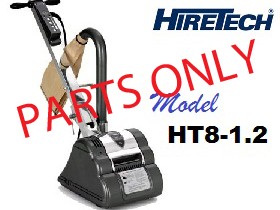
Hiretech’s HT8 drum sanders have been around for decades. With several refinements incorporated over the years, please ensure you are ordering parts for the correct model, some of which have red side guards and the later models grey.
- Clamp bar style drum uses 8″ x 19½” notched sheets; expanding drum offered on later models
- Often used for deck sanding
- Will remove paint and other materials from concrete or wood as well
- Lifting pin assembly on drum allows two-handed replacement of sandpaper
- Wrap around rubber drum face can be replaced in minutes, without removing the sanding drum
- Access to motor permits brush changes
- Removable handle assembly
- Solid steel wheels
- Optional paper dust bags
- Full range of sandpaper available from 16 to 120 grit
| Model Number: | 07006 (Split drum; uses sheets) |
| Motor Specs: | 15 Amp/110Volt 1½ Horsepower 60 Hz, Continuous Heavy Duty |
| Sanding Drum Speed: | 3,300 Revolutions per minute |
| Sanding Drum Size: | 8″ (20.32cm) wide |
| Paper Size: | 8″ x 19½” (23 x 49½cm) with notched and angled ends |
| Wheels: | Solid steel (2 used) |
| Air Flow/Fan Speed: | Approximately 76 Cubic Feet per Minute |
| Power Cord: | 23′ (7m) black non-marking |
| Dimensions (LxWxH): | 37″ (94cm) Long x 12½” (32.2cm) Wide x 33½” (8½cm) High |
| Shipping Dimensions: | 15¾” (40cm) Wide x 30¾” (78cm) Long x 17½” (44cm) High |
| Weight: | 41½Kg (91 Lbs) |
| Shipping Weight: | 50 Kg (110.3 Lbs) |
- Empty the dust bag when it reaches the ½ full mark. Never leave debris in the bag for any length of time. Spontaneous combustion can result from this, especially if the material being sanded is damp (ie. decks).
- Periodically inspect the power cord for defects. These machines will eat anything in their paths!
- It’s advisable to keep the last sanding sheet or belt used, attached to the drum for added protection from gravel and other debris. Periodically check the sanding drum for gouges or grooves, which are often caused by running the machine over nails or staples that weren’t removed during the preparation process.
- Check the cogged drive belts occasionally for proper tension and alignment. These stretch over time. A belt which is too loose can contribute to excessive vibration resulting in chatter marks, while a belt too tight can cause premature bearing wear.

 Canadian Owned and Operated
Canadian Owned and Operated